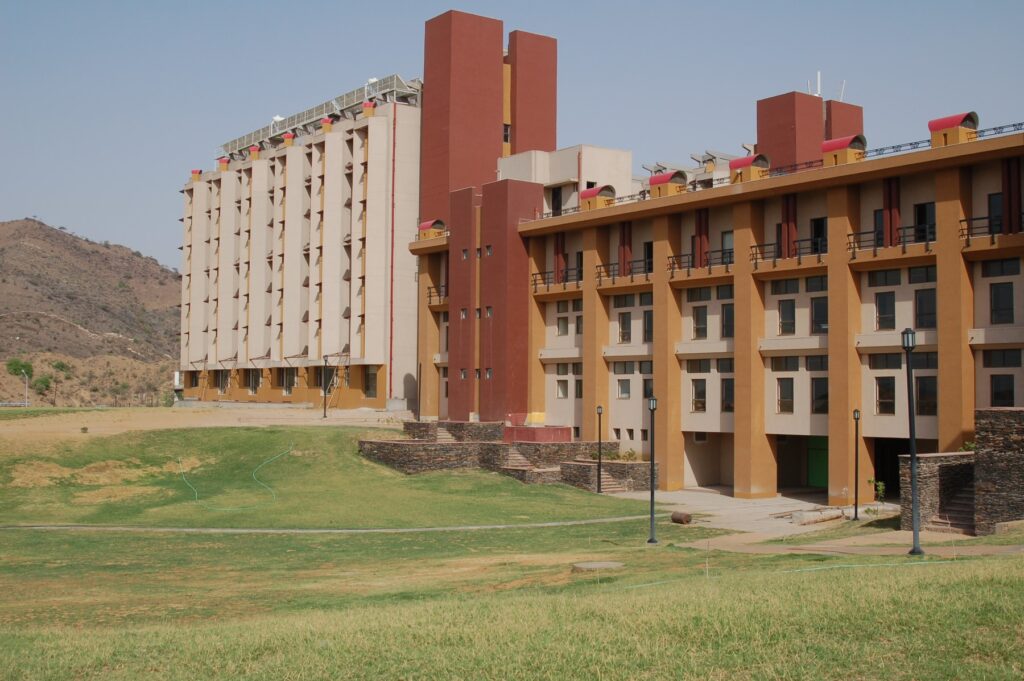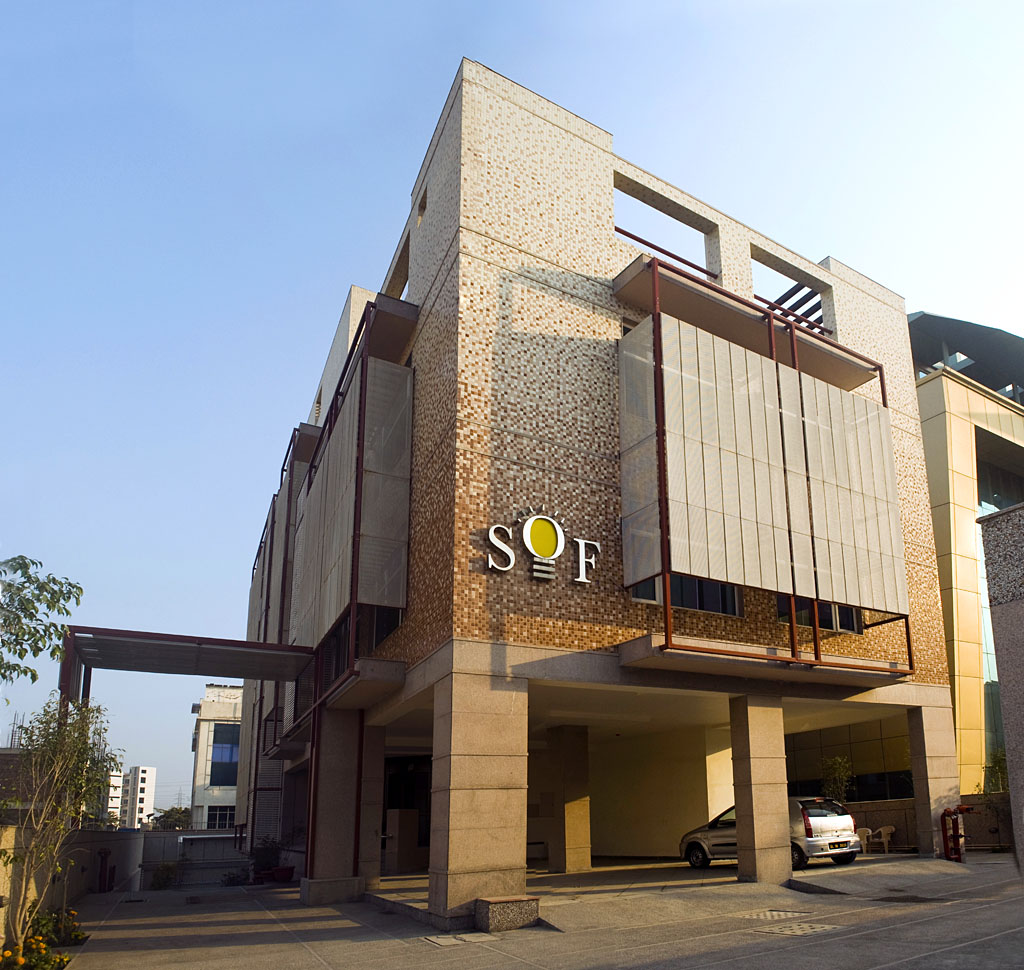Author/architect/academician Suneet Paul, former editor-in-chief of Architecture + Design, recently interacted with Dr. Vinod Gupta on some pertinent issues in the profession. Below are a few highlights from the conversation.
Suneet Paul:
Dr. Gupta, like always, it is a pleasure conversing with you.
Creativity in architecture is a constant. With your focus now more on research-based design and production of ergonomically suitable office and institutional furniture, you have diverted energies from building/campus planning. What led to this shift?
Vinod Gupta:
I started with the ergonomic design of workplaces about 40 years back when computers were just being introduced in Indian offices. When others were talking about keyboard drawers and ergonomic chairs, I focused on the work arrangement with the table at its centre. There were no international examples available for this and the challenge was to get clients to accept things that were not found in international catalogues.
Fortunately, some clients allowed me to experiment and I am happy to say that several of the new ideas that we used, are now accepted as normal ways of working. Further, I enjoy working at different scales so I have been designing buildings and campuses and designing furniture at the same time.
Suneet Paul:
There are multiple international furniture companies which have entered the Indian market with standardized office furniture variations. Two things—first, in your opinion, are they a success in providing the appropriate workplace efficiency in design variations, and second, is the Indian clientele sensitive to ergonomic detail that is so much desired?
Vinod Gupta:
The international companies are in the Indian market to sell mainly to multi-national clients. Their furniture is not meant for Indian companies with Indian work culture. The law in Europe does not permit an office to let staff work on laptops for anything more than an hour or so, but in India, many offices use only laptops for work all day. Laptops have to be used with a different table and this difference is missed by Indians. The result is a very poor ergonomic standard for office design.
Suneet Paul:
You are also into designing research-based school furniture and have often with a rationale, questioned accepted norms in design. What’s your take on the understanding/awareness of school managements towards the importance of the right ergonomics for the young one’s physical/mental well-being?
Vinod Gupta:
My work with school furniture has been about giving schools the opportunity to use new pedagogic methods that the National Education Policy 2022 requires them to switch to. This calls for re-training teachers to use the new methods but schools are reluctant to do this. NEP 2020 also brought about changes in the educational syllabus and some schools have a problem with those and there is an undercurrent that wants to resist the implementation of the policy.
But ergonomics is not just about school furniture, it deals with the total environment in the class room. I am concerned that the methods being used to deal with summer temperatures are leading to poor environmental quality in classrooms. School managements do not understand this.
Suneet Paul:
Your architecture no doubt showcases the extreme efforts to contextualize the project to the terrain/climate and bring forth the relevance of utilizing local/sustainable materials. Energy-efficient design has obviously been high on the priority.
In your dealings, how difficult/easy is it to bring the client to the same page of acceptance of such solutions, especially in today’s age of glitz and glamour with global styles being the preference as we witness all around?
Vinod Gupta:
I can quote an example here. For an office building where the client asked for a smart building with all manner of automation, I set my goal as an energy-efficient and environment-friendly building. The two ideas were overlapped but the solutions required were not the same. I had to sell the environment-friendly design as smart and persuade the client to go with it. I think I have been successful in carrying though my principles without any major compromise.
Suneet Paul:
Dr. Gupta, your commitment to academics in architecture and design have been deep rooted, first as a faculty in the earlier stages, then as a visiting professor and now as an adviser/board member of architecture colleges. We all hear about the crisis/dismal student intake for architecture colleges pan India. What would you say about the state of architecture education in India in the current phase?
Vinod Gupta:
Let me point out to you that many engineering colleges are also facing a shortage of new entrants. This is something to do with the kind of jobs that graduates are able to get in our country.
That said, I think the architectural profession is going through a crisis and it shows up in the low student intake in architecture schools. In the current method of working for large projects, it is the Project Management Consultant who runs the show, and his goals include management of deadlines and budgets, they do not include ’ensuring good architecture’.
Architectural practices are therefore, indulging in checkbox architecture, just making sure that they deliver the ‘deliverables’ and nothing more. In this situation, the architectural firms are paid poorly and in turn they are unable to pay a living wage to their staff and hence a declining student intake in architectural schools.
Suneet Paul:
And as a distinguished architecture practitioner and an ardent author/writer who has travelled extensively and delivered talks/presentations at various important occasions, any comments on the present and future of architecture in the country? Taking a bird’s eye view, has contemporary Indian architecture according to you, made a mark on the global stage?
Vinod Gupta:
Over the last twenty years, the scale of projects has changed in India and the big projects are equal to big projects elsewhere in the world. It is not uncommon to see international architectural and planning firms being hired to design large projects in India, followed by an Indian firm to carry the design through. So, it is a bit difficult to say what is Indian architecture. There are Indian firms that have done creditable work in India but I do not know any Indian design practice that has become a player on the international scene. This may well be just my ignorance.
Suneet Paul:
Art and architecture, since centuries, have always gone hand-in-hand and enjoyed a cozy rapport. In the present context, with technology making mega strides, interpretations of art in architecture are also being redefined. Artificial intelligence is strongly making its presence felt. How comfortable are you with the at times, dramatic transformations to the natural emotive human aesthetics with these technology-driven interventions?
Vinod Gupta:
Building technology has always influenced the architect’s work and some well-known international architects have established themselves because they used new design and construction technology that others were not willing or able to employ.
The construction sector employs a very large workforce in India. In case we embrace mechanical technology like 3D printing for large-scale construction, we may end up losing many employment opportunities. I think we need to use some of the new technology to enhance productivity and ensure better performance but that calls for setting clear goals that have eluded us in the past. I think some of the new tech like parametric design is responsible for creating innovative but hugely wasteful designs.
To sum this up, new technology is always exciting but we need to choose only that which will meet our social goals.
Suneet Paul:
You are a technical adviser to various professional governmental/ private sector Committees and Boards. If I could ask you, what’s your holistic push here to make them more result-driven with innovative/practical directional thrust?
Vinod Gupta:
Committees come with a limited mandate and they are useful for making technical recommendations. Very few committee members have the resources to carry out the detailed work needed to suggest implementable recommendations. I find myself stepping out of mandate and making recommendations for structural changes that, I believe, will bear fruit over the long term. If there is one change that one needs it is for committees to look beyond results in the short term.
Suneet Paul:
We are a developing country with great aspirations in a population of around 1.4 billion people. Professionals and people in position have great opportunities to lead on with progressive mindsets. With your vast and diverse exposure in architecture and design, would you have any boosters for the young architects/students in architecture to enthuse their faith in the profession and make a positive difference in our built habitat?
Vinod Gupta:
We are living in the time of global aspirations, information avalanche and instant gratification. In this age our goals are set by others—‘did you get your order within ten minutes?’, and ‘how was the behaviour of the delivery boy?’
It would be great for the youth to focus on the value that resides in the product and not the quality of delivery.
The architectural school training creates many opportunities in allied fields. The young architects will do well if they do not limit themselves to the traditional role of an architect and are willing to make a contribution in other design disciplines.
Suneet Paul:
Yes, well, a focus is definitely is required to the basics. Thank you for the spontaneity in your responses.
For reference, a list of a few prominent projects designed by the architecture firm:




Other prominent designs: KLG Systel Ltd. office buildings, Gurgaon; American Institute of Indian Studies, Delhi; National Media Centre Housing, Gurgaon; CMC Limited office building, Mumbai; Solar Energy Centre, Gurgaon; Lake Tivoli Apartments, Kissimmee, Florida

Delhi-based architect, Dr. Vinod Gupta is a renowned name for his innovative approach for environment friendly and energy-efficient-architecture and interior design. As a partner, first in the firm Space Design Associates and then Space Design Consultants, over a span of forty plus years, he has been keenly involved with numerous prestigious building projects in India. He is also the CEO of Opus Indigo Designs Pvt. Ltd.—a furniture design/production firm for educational and office spaces and exhibition systems.
He is a member of numerous professional Institutes/Boards/Commissions in the country. His sustained contribution to academics in architecture and industrial design has been intense through his association with the School of Planning, Delhi, and other institutes. Dr. Gupta has authored/edited books in the fields of building energy efficiency and furniture ergonomics. His research-based articles have been published in journals and magazines in India and abroad. Dr. Gupta has been applauded with esteemed awards for his contributions to architecture.



